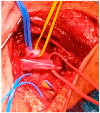Diagnostic and Therapeutic Approach to Thoracic Outlet Syndrome
- PMID: 39330749
- PMCID: PMC11436167
- DOI: 10.3390/tomography10090103
Diagnostic and Therapeutic Approach to Thoracic Outlet Syndrome
Abstract
Thoracic outlet syndrome (TOS) is a group of symptoms caused by the compression of neurovascular structures of the superior thoracic outlet. The knowledge of its clinical presentation with specific symptoms, as well as proper imaging examinations, ranging from plain radiographs to ultrasound, computed tomography and magnetic resonance imaging, may help achieve a precise diagnosis. Once TOS is recognized, proper treatment may comprise a conservative or a surgical approach.
Keywords: CT; MRI; US; diagnosis; surgery; thoracic outlet syndrome; treatment.
Conflict of interest statement
The authors declare no conflict of interest.
Figures





References
Publication types
MeSH terms
LinkOut - more resources
Full Text Sources
Medical

